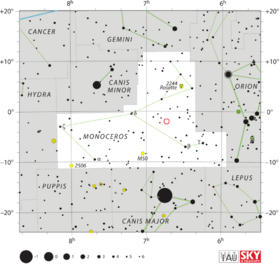Astronomy:BT Monocerotis
| Observation data Equinox J2000.0]] (ICRS) | |
|---|---|
| Constellation | Monoceros |
| Right ascension | 06h 43m 47.242s[1] |
| Declination | −02° 01′ 13.88″[1] |
| Apparent magnitude (V) | 4.5 – 15.8[2] |
| Characteristics | |
| Spectral type | D/G8V |
| Variable type | Eclipsing binary[3] |
| Astrometry | |
| Distance | 1,413 ± 97[4] pc |
| Details | |
| Mass | 1.04/0.87[3] M☉ |
| Rotational velocity (v sin i) | —/138[3] km/s |
| Other designations | |
BT Mon, Nova Monocerotis 1939, 2MASS J06434723-0201139, AAVSO 0638-01, Gaia DR2 3106991818813980416 | |
| Database references | |
| SIMBAD | data |
BT Monocerotis (Nova Monocerotis 1939) was a nova, which lit up in the constellation Monoceros in 1939. It was discovered on a spectral plate by Fred L. Whipple on December 23, 1939.[5] BT Monocerotis is believed to have reached mag 4.5, which would have made it visible to the naked eye, but that value is an extrapolation; the nova was not observed at peak brightness[2] Its brightness decreased after the outbreak by 3 magnitudes in 182 days, making it a "slow nova".[6] The light curve for the eruption had a long plateau period.[5]

Photographic plates taken for 30 years prior to the eruption show that BT Monocerotis remained visible during that period. Prior to 1933, BT Monocerotis had an average magnitude of 15.52 with a variation of 1.2 magnitudes. It retained the same magnitude until the eruption, showing a variation of 0.9 magnitudes. Thus it did not show a pre-eruption rise in brightness.[5]
This is an interacting binary star system consisting of a 1.04±0.06M☉ white dwarf primary star and a 0.87±0.06M☉ main sequence star with a stellar classification of G8V.[9] The orbit has a period of 0.33381379 days[5] and an inclination of 88.2° to the line of sight to the Earth, resulting in an eclipsing binary.[3] The nova eruption is believed to have been driven by mass transferred from the secondary star to the white dwarf.[10] It remains uncertain whether the white dwarf has an accretion disk formed by this material. Matter outflowing from the system has a line of sight velocity of 450 km s−1, but may be moving at up to 3,200 km s−1 if the flow is strictly bipolar.[11]
References
- ↑ 1.0 1.1 Brown, A. G. A. (August 2018). "Gaia Data Release 2: Summary of the contents and survey properties". Astronomy & Astrophysics 616: A1. doi:10.1051/0004-6361/201833051. Bibcode: 2018A&A...616A...1G. Gaia DR2 record for this source at VizieR.
- ↑ 2.0 2.1 Robinson, E.L. (July 1975). "Preeruption light curves of novae". The Astronomical Journal 80: 515–524. doi:10.1086/111774. Bibcode: 1975AJ.....80..515R. https://ui.adsabs.harvard.edu/abs/1975AJ.....80..515R. Retrieved 26 December 2020.
- ↑ 3.0 3.1 3.2 3.3 Smith, D. A.; Dhillon, V. S.; Marsh, T. R. (1998). "The mass of the white dwarf in the old nova BT MON". in S. Howell. 137. p. 477. Bibcode: 1998ASPC..137..477S.
- ↑ Selvelli, Pierluigi; Gilmozzi, Roberto (February 2019). "A UV and optical study of 18 old novae with Gaia DR2 distances: mass accretion rates, physical parameters, and MMRD". Astronomy & Astrophysics 622: A186. doi:10.1051/0004-6361/201834238. Bibcode: 2019A&A...622A.186S.
- ↑ 5.0 5.1 5.2 5.3 Collazzi, Andrew C. (December 2009). "The Behavior of Novae Light Curves Before Eruption". The Astronomical Journal 138 (6): 1846–1873. doi:10.1088/0004-6256/138/6/1846. Bibcode: 2009AJ....138.1846C.
- ↑ Özdönmez, Aykut; Ege, Ergün; Güver, Tolga; Ak, Tansel (May 2018). "A new catalogue of Galactic novae: investigation of the MMRD relation and spatial distribution". Monthly Notices of the Royal Astronomical Society 476 (3): 4162–4186. doi:10.1093/mnras/sty432. Bibcode: 2018MNRAS.476.4162O. https://ui.adsabs.harvard.edu/abs/2018MNRAS.476.4162O. Retrieved 26 December 2020.
- ↑ Schaefer, Bradley E.; Patterson, Joseph (May 1983). "Orbital periods of novae before eruption". The Astrophysical Journal 268: 710–717. doi:10.1086/160992. Bibcode: 1983ApJ...268..710S.
- ↑ "MAST: Barbara A. Mikulski Archive for Space Telescopes". Space Telescope Science Institute. https://mast.stsci.edu/portal/Mashup/Clients/Mast/Portal.html.
- ↑ Smith, D.A.; Dhillon, V.S.; Marsh, T.R. (May 1998). "The mass of the white dwarf in the old nova BT MON". Monthly Notices of the Royal Astronomical Society 296 (3): 465–482. doi:10.1046/j.1365-8711.1998.00743.x. Bibcode: 1998MNRAS.296..465S.
- ↑ Knigge, Christian (December 2006). "The donor stars of cataclysmic variables". Monthly Notices of the Royal Astronomical Society 373 (2): 484–502. doi:10.1111/j.1365-2966.2006.11096.x. Bibcode: 2006MNRAS.373..484K.
- ↑ Kafka, S.; Honeycutt, R. K. (November 2004). "Detecting Outflows from Cataclysmic Variables in the Optical". The Astronomical Journal 128 (5): 2420–2429. doi:10.1086/424618. Bibcode: 2004AJ....128.2420K.
External links
 |


